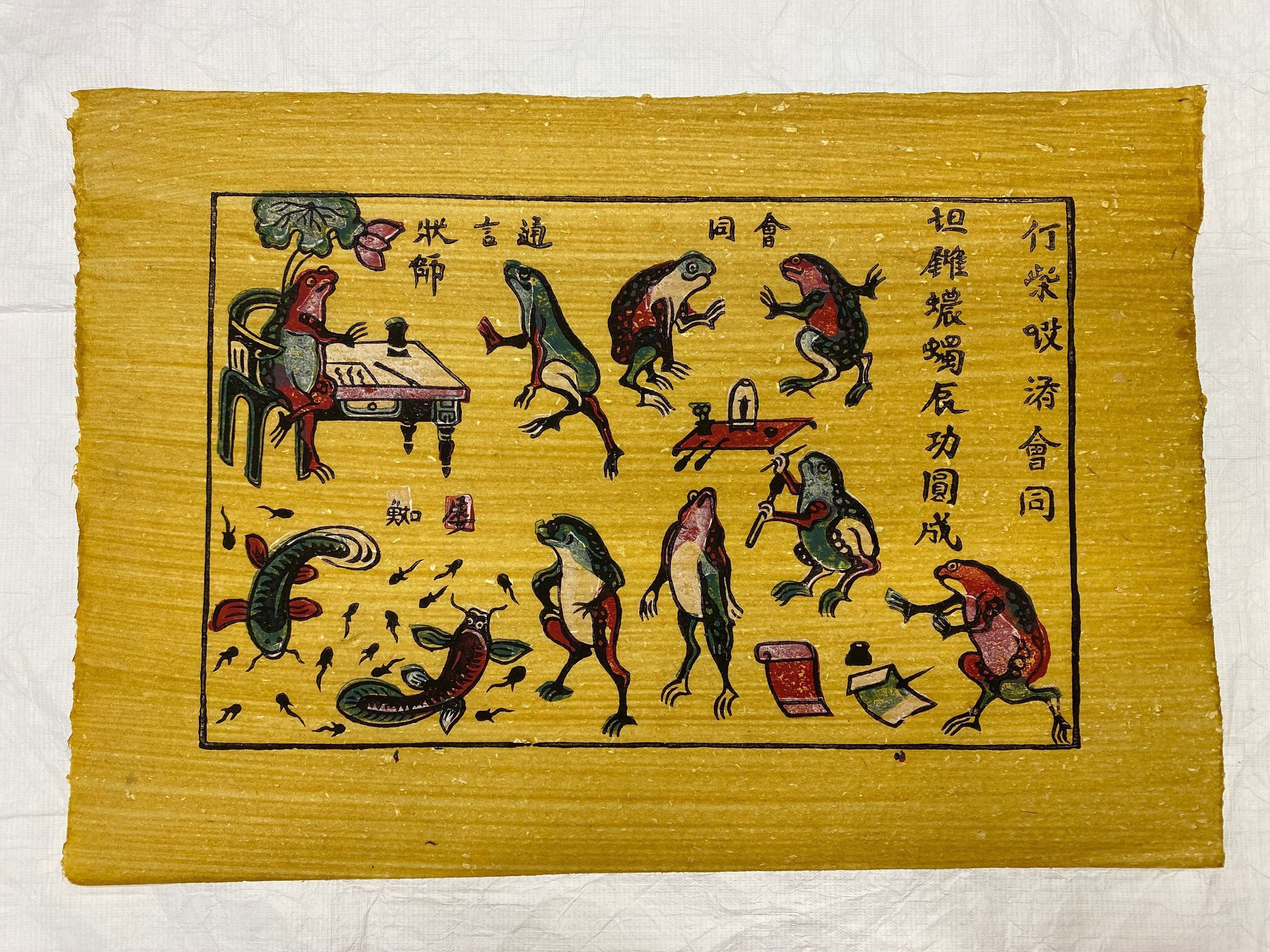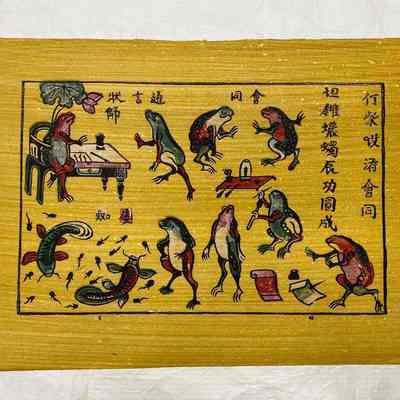Name/Title
Ðông Hồ Portfolio Thầy Đồ Cóc (The Frog Teacher)Entry/Object ID
2019.P-G.078GDescription
Traditional Vietnamese folk woodblock print on plant fibrous paper horizontally depicts the story of the frog teacher. From left to right this story illustrates a series of frogs engaging human-like in studious activities such as reading and writing or watching as fish swim with tadpoles.
Chữ Nôm characters are across the top and vertically on the left of the print. (Version 1)Context
The original meaning or translation for this painting is unknown but this painting shares a similar subject matter to another version of a painting Thầy Đồ Cóc.
This painting represents the virtues of a strong desire for knowledge and respect for teachers.
It might also be that the meaning of this painting may have something to do with the possibility according to ancient history, the Vietnamese had a type of script called "Chữ Khoa Đẩu," which is known as the "Tadpole script." A tadpole is the offspring of a toad, or in other words, the product of the toad. Thus, it is natural that the toad teacher would teach tadpoles, frogs, and tadpole-like writing. This interpretation however is controversial as "Chữ khoa đẩu" is a term claimed by the Vietnamese pseudohistorian Đỗ Văn Xuyền.
*Characters yet to be translated
From insert in boxset about series, directly transcribed:
A Brief Overview of "Ðông Hồ" Folk Paintings:
The "Dong Ho" folk paintings have been around for nearly 500 years. The themes of these paintings were inspired by everyday life and created by artisans' observations and experiences.
The main themes include:
Congratulatory paintings, which reflect the common wishes of people: a happy family, longevity, wealth, and prosperity, as seen in paintings such as Phú Quý (Wealth and Nobility), Vinh Hoa (Glory), Gà Đàn (Hen and Chicks), Lợn Đàn (Pigs).
Paintings depicting festivals and traditional activities, such as wrestling contests, drum carrying, buffalo fighting, as well as daily life scenes like đánh ghen (a fight between women over a man), hứng dừa (picking coconuts), thầy đồ cóc (the frog teacher), đám cưới chuột (a mouse wedding), and folklore stories such as Trê Cóc Kiện Nhau (Catfish and Frog Suing Each Other), Đinh Bộ Lĩnh (founding emperor of the short-lived Đinh dynasty), and Bà Triệu (legendary Vietnamese heroine).
Over many generations, artisans creatively used available local materials to craft these artworks.
Initially, the images were carved onto wood, usually wood from the thị tree, thừng mực wood, or vàng tâm wood. These carvings were then printed onto dó paper, which had been coated with a special resin. Dó paper is handmade from the bark of the dó tree, while the resin is made from the shells of dead mollusks, cleaned, crushed, and mixed with rice paste. The mixture was applied to the paper with a brush made from dry pine leaves, creating the texture that gives the painting life.
The artisans used only a few natural materials to create the colors: red from clay, green from tràm leaves or copper rust, white from diệp powder, yellow from the hoè tree flowers, and black from ash made from bamboo leaves or rice straw.
The patterns were carefully printed and harmoniously arranged, creating a unique identity. In the rich collection of Vietnamese folk art, the "Dong Ho" paintings stand out as a distinct form of expression, originating from the village of Dong Ho in Thuận Thành district, Bắc Ninh province.Collection
Palmeri-Goodstein Research Print CollectionLexicon
Search Terms
Longevity, Life, Abundance, Wealth, Luck, Prosperity, Nature, Symbolic, Allegory, Amphibian, Teacher, EducationDimensions
Height
10-1/4 inWidth
14-5/8 inHeight
7-1/8 inWidth
11-1/4 in
